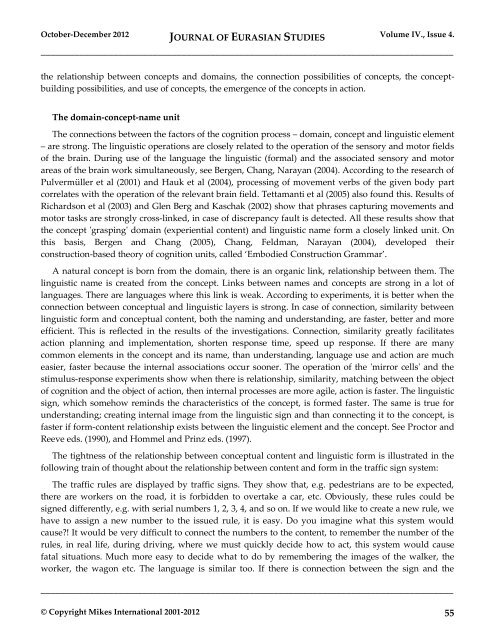Create successful ePaper yourself
Turn your PDF publications into a flip-book with our unique Google optimized e-Paper software.
October-December 2012 JOURNAL OF EURASIAN STUDIES Volume IV., Issue 4.<br />
_____________________________________________________________________________________<br />
the relationship between concepts and domains, the connection possibilities <strong>of</strong> concepts, the conceptbuilding<br />
possibilities, and use <strong>of</strong> concepts, the emergence <strong>of</strong> the concepts in action.<br />
The domain-concept-name unit<br />
The connections between the factors <strong>of</strong> the cognition process – domain, concept and linguistic element<br />
– are strong. The linguistic operations are closely related to the operation <strong>of</strong> the sensory and motor fields<br />
<strong>of</strong> the brain. During use <strong>of</strong> the language the linguistic (formal) and the associated sensory and motor<br />
areas <strong>of</strong> the brain work simultaneously, see Bergen, Chang, Narayan (2004). According to the research <strong>of</strong><br />
Pulvermüller et al (2001) and Hauk et al (2004), processing <strong>of</strong> movement verbs <strong>of</strong> the given body part<br />
correlates with the operation <strong>of</strong> the relevant brain field. Tettamanti et al (2005) also found this. Results <strong>of</strong><br />
Richardson et al (2003) and Glen Berg and Kaschak (2002) show that phrases capturing movements and<br />
motor tasks are strongly cross-linked, in case <strong>of</strong> discrepancy fault is detected. All these results show that<br />
the concept 'grasping' domain (experiential content) and linguistic name form a closely linked unit. On<br />
this basis, Bergen and Chang (2005), Chang, Feldman, Narayan (2004), developed their<br />
construction-based theory <strong>of</strong> cognition units, called ‘Embodied Construction Grammar’.<br />
A natural concept is born from the domain, there is an organic link, relationship between them. The<br />
linguistic name is created from the concept. Links between names and concepts are strong in a lot <strong>of</strong><br />
languages. There are languages where this link is weak. According to experiments, it is better when the<br />
connection between conceptual and linguistic layers is strong. In case <strong>of</strong> connection, similarity between<br />
linguistic form and conceptual content, both the naming and understanding, are faster, better and more<br />
efficient. This is reflected in the results <strong>of</strong> the investigations. Connection, similarity greatly facilitates<br />
action planning and implementation, shorten response time, speed up response. If there are many<br />
common elements in the concept and its name, than understanding, language use and action are much<br />
easier, faster because the internal associations occur sooner. The operation <strong>of</strong> the 'mirror cells' and the<br />
stimulus-response experiments show when there is relationship, similarity, matching between the object<br />
<strong>of</strong> cognition and the object <strong>of</strong> action, then internal processes are more agile, action is faster. The linguistic<br />
sign, which somehow reminds the characteristics <strong>of</strong> the concept, is formed faster. The same is true for<br />
understanding; creating internal image from the linguistic sign and than connecting it to the concept, is<br />
faster if form-content relationship exists between the linguistic element and the concept. See Proctor and<br />
Reeve eds. (1990), and Hommel and Prinz eds. (1997).<br />
The tightness <strong>of</strong> the relationship between conceptual content and linguistic form is illustrated in the<br />
following train <strong>of</strong> thought about the relationship between content and form in the traffic sign system:<br />
The traffic rules are displayed by traffic signs. They show that, e.g. pedestrians are to be expected,<br />
there are workers on the road, it is forbidden to overtake a car, etc. Obviously, these rules could be<br />
signed differently, e.g. with serial numbers 1, 2, 3, 4, and so on. If we would like to create a new rule, we<br />
have to assign a new number to the issued rule, it is easy. Do you imagine what this system would<br />
cause?! It would be very difficult to connect the numbers to the content, to remember the number <strong>of</strong> the<br />
rules, in real life, during driving, where we must quickly decide how to act, this system would cause<br />
fatal situations. Much more easy to decide what to do by remembering the images <strong>of</strong> the walker, the<br />
worker, the wagon etc. The language is similar too. If there is connection between the sign and the<br />
_____________________________________________________________________________________<br />
© Copyright Mikes International 2001-2012 55

















